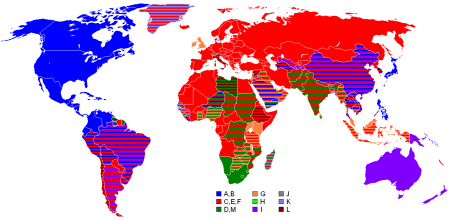You don’t know how much you miss not being able to look up the location of CPU fabrication plants in Israel when the question strikes your brain…until it’s taken away from you. However, I’m happy to report that I’ve got internet at my house again. So long to Orange Telecom, widely regard as a flaky provider, and hello to Umnia’s “Double Turdo” service, which has a less-known level of flakiness! Hello to 20GB monthly limits instead of 10GB, and 2Mb speed instead of 1Mb (or at least supposedly). The internet in Jordan is neither America nor Korea, but it’s good to be able to use Remote Desktop again and look up questions like the aforementioned. (Qiryat Gat, by the way.)
The rant of the night is the lack of a standardized power plug in Jordan. This country has a ridiculous lack of standardization, and it seems to be the worse when it comes to just choosing a power plug to use. Check out this map:
It’s one thing to have this entire country filled with so many plug standards I have to carry a sack of clinking adapters in my backpack to make sure I’ll be able to plug in my laptop where I need to work. That’s bad enough. It’s even worse when we have four different plug standards at the training center in Ayn al Basha!
When I first came to Ayn al Basha, the only building that had electricity (or even existed for that matter) was the lime-green administration building. All the plugs in there are using the Italian “L” standard; three prongs in a straight line. Then when we built the first classrooms in September and October of 2008, the electricians put in the German “Schuko” style plug. Now, after I returned from America on my vacation, I discovered that some numbskull had wired my new classroom with British “MK” plugs – my most-despised type of plug that’s used here. Then, just a couple days ago while I was with the TOT class in the assembly room, I saw that the plugs there were using some weird hybrid of the USA “A” standard, combined with widened holes to fit the “Europlug.” Supposedly, it’s some sort of Chinese sub-standard. You know what really gets me? Aaron told me that the electrician that did up my new computer lab was the same one who installed the “Schuko” plugs in all the other classrooms last year, so he should have known better than to just stick another random outlet standard into the walls. It’s just a coincidence that because of their complexity, MK outlets cost twice and cables cost thrice more as any other type, right? Hmmm.
The British MK outlet and plug are indeed the absolute worse, relics of the 1930’s with a plug that requires its own built-in fuse and an outlet box that usually has an utterly pointless power switch next to it. The pins on the MK are huge, ungainly, and if you are unlucky enough to step on one in the middle of the night you will beg for death. “They’re impossible to break, though,” some of my English friends here will say with a grin, and one even proudly showed me a thick ugly scar on his right foot where he drove an MK a centimeter through his sole while running across a room to answer a phone. The MK needs to die. Or at least, Jordan needs to stop using it – but it’s unlikely, seeing that it’s probably second after the Europlug in the number of buildings it’s used in.
The Europlug – a bland, non-grounded little weak thing. Most lower-amperage devices in Jordan use this style of plug, and mercifully it seems to fit into most of the outlets found here. However, because of its lack of ground, it’s useless for computers. Also, they also feel like they’re going to fall apart in my hand. Pass.
The “Schuko” plug would definitely be my favorite if the American “B” standard didn’t exist. Strong and sturdy with an ingenious way to add a ground wire to the system. Philip thought ahead when he had his house built and had each wall outlet contain two sockets – one using the Italian “L” plug and the other using the “Schuko.” The only problem with them is that they’re still too large for my taste. When I need to buy power strips (which is quite a bit), you can only fit four “Schuko” plugs on there, like the MK. If you tried to sell a power strip in America with only four outlets on it, you’d be tarred and feathered. By me, at least, if no one else would.
The USA “NEMA 5” plug is by far the best of them all, and after having to work with this bizarre hodgepodge for the past year, I don’t think I’ll find much resistance to that claim. Our plugs and outlets are like our citizens: a well-grounded combination of strength, size, and electrical amperage. It’s no shock that we invented electricity, really, and it feels good to be able to say for once that America is indisputably the best at something besides starting wars. Without further ado…

USA! USA! USA! USA!
Glad I got that out of my system.



No one has commented on this post - please leave me one, I love getting feedback!
Follow this post's comments, or leave a Trackback from your site